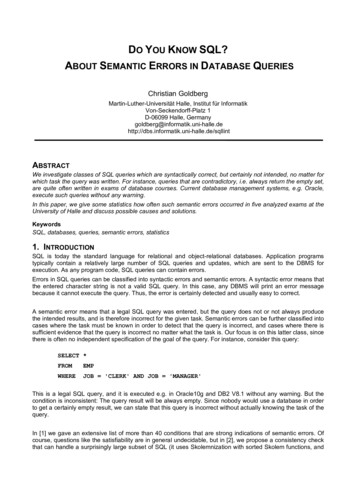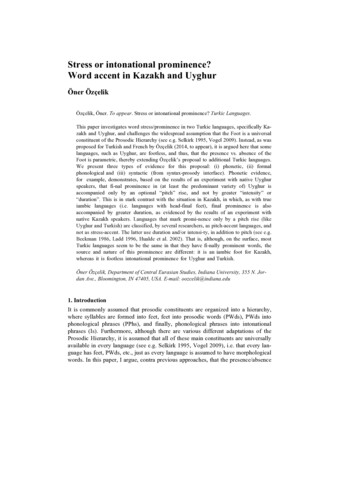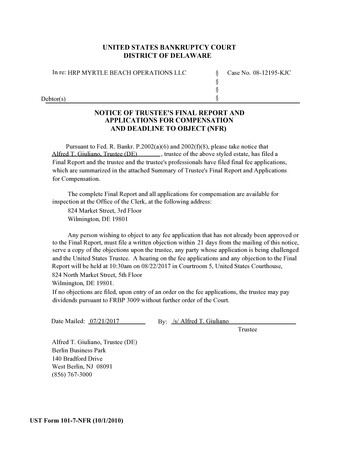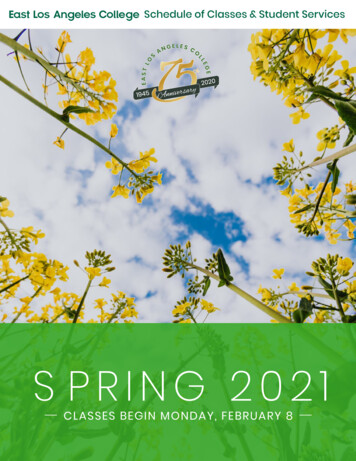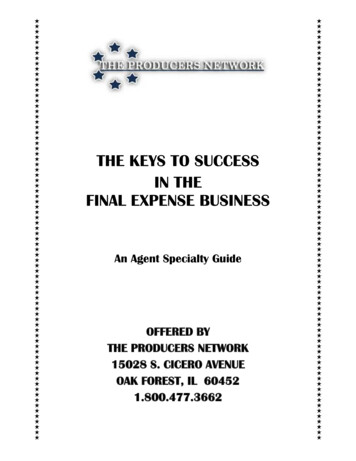
Transcription
Made In B.C. – Volume VIIA H istory of Postsecondary E ducation in British ColumbiaPost-BaccalaureateProgramsBob CowinDouglas CollegeMarch 2013
PrefaceEnrolment may be small compared to other educational sectors in British Columbia, but a disproportionateshare of opinion makers and society’s change agents have participated in the programs described in thispaper. These programs represent a growing aspect of postsecondary education, one that has received a fairamount of attention in government and institutions.Yet despite all this, and my own sense that post-baccalaureate programs matter a great deal, I hesitated totackle the topic of post-baccalaureate programming. I feared that my source material might be fine grainedand dispersed – no simple synthesis and summary here. My fears turned out to have some basis: howevermuch postsecondary educators might ponder and discuss trends in their work environment, publiclyaccessible articles about credential creep, the long term impact of competing for research funding, or theimplications of scrambling for academic prestige in BC are scarce.Once again, this volume is simply another starting point, an extended briefing note that seeks to be broadrather than deep. Its goal is consolidate information so that well contextualized decisions might be madeabout the future of postsecondary education in BC.Part of her argument is that the reason cultures die, or enter a dark age,is that they begin to lose the memory of their story .This is especially so in our increasingly pluralistic neighbourhoods[postsecondary institutions] characterized by multiple and often competingstories about the nature and meaning of life [education].- Alan Roxburgh commenting on Jane Jacobs[Text in square brackets added]
Other papers in this series on the history of postsecondary education in British Columbia: Overview (2007)Faith-Based Institutions (2009)Continuing Education in Public Institutions (2010)Aboriginal Postsecondary Education (2011)Apprenticeship and Pre-Apprenticeship Training (2012)Agencies and Organizations (2012)Available electronically in the ERIC database at: www.eric.ed.govand in the Douglas College library at http://innopac.douglas.bc.caLibrary and Archives Canada Cataloguing in PublicationCowin, Bob, 1954Post-baccalaureate programs / Bob Cowin. (Made in B.C.: a history of postsecondary education inBritish Columbia; v. 7)Includes bibliographical references.ISBN: 97818960193691. Postsecondary education--British Columbia. 2. Universities and colleges--British Columbia--History.3. Education, Higher--British Columbia--History. I. Title. (Series)LA418.B7 C695 2013378.711
ContentsSummaryIntroductionScope of the PaperOrganization of the Paper11Graduate StudiesContextAcademic versus Professional DegreesFederal Influence on Former Teaching InstitutionsPublic InstitutionsResearch UniversitiesUniversity of British ColumbiaSimon Fraser UniversityTechnical University of British ColumbiaUniversity of VictoriaUniversity of Northern British ColumbiaTeaching Intensive UniversitiesOther InstitutionsBC Institute of TechnologyPrivate InstitutionsBased in British ColumbiaQuest UniversityUniversity of Canada WestFaith-Based InstitutionsComprehensiveTrinity Western UniversityTheologicalAssociated Canadian Theological SchoolsCanadian Graduate School of MinistryCarey Theological CollegeRegent CollegeSeminary of Christ the KingSt. Mark’s CollegeVancouver School of TheologyOut-of-ProvinceAdler School of Professional PsychologyCity UniversityFairleigh Dickinson UniversityLansbridge University of New BrunswickNew York Institute of TechnologyQueen’s UniversityUniversity of PhoenixMaster’s Programs for TeachersInstitutions Assessed by DQAB but Not OfferingGraduate Programs in 1313141414Professional ProgramsAccountingChartered AccountantsCertified General AccountantsCertified Management Accountants171717171815
ArchitectureCommunity and Regional PlanningEducationEngineeringHealthMedicineOther Health SciencesDentistryNursingComplementary MedicineBoucher Institute of Naturopathic MedicineHuman ServicesLawUniversity of British ColumbiaUniversity of VictoriaThompson Rivers 2232324Post-Degree Certificates, Diplomas and Second DegreesUndergraduate LevelPublic InstitutionsSimon Fraser UniversityUniversity of British ColumbiaUniversity of Northern British ColumbiaUniversity of VictoriaBritish Columbia Institute of TechnologyCapilano UniversityOther InstitutionsTeacher EducationPrivate InstitutionsKutenai Art Therapy InstituteGraduate y FormatsFor-Profit InstitutionsNomenclatureQuality AssuranceResearchTrendsTuition Fees3030303030313131References32AppendixBC Public InstitutionsMap333334
SummaryThis paper considers programs that require a bachelor’s degree, not necessarily in the same field, for entryto the program. They are equivalent to at least one semester of full-time study, with at least some of theinstruction delivered face-to-face in BC. Student learning may be evaluated for academic credit, forprofessional certification, or for both. Public institutions, private for-profit institutions, private not-forprofit institutions, and professional organizations all lie within its scope.The paper describes a representative sample of programs and institutions, and does not provide a completeinventory. The focus is on how programs were established, not on everything that has happenedsubsequently.Graduate ProgramsAlthough a few graduate programs existed prior to World War II, postsecondary education in BC until themid 1940s consisted mainly of undergraduate teaching institutions and various apprenticeship and articlingopportunities. With the growth of research funding from the federal government, graduate education beganexpanding in the 1950s and, by the 1960s, doctoral education had become common (although it was notuntil the early seventies that the debate in universities about the relative emphasis that should be accordedteaching and research waned as research became increasingly dominant.) Echoes of that debate have beenheard since 1990 in a number of institutions that were originally established as community colleges.Although John Macdonald’s seminal report of 1962, Higher Education in British Columbia and a Plan forthe Future, envisioned the University of British Columbia as the centrepiece with large graduate programsand two additional undergraduate colleges awarding bachelor’s degrees, both the University of Victoria(established in 1963) and Simon Fraser University (1965) have offered graduate programs since theyopened.Simon Fraser University’s original notion of teaching assistants in the late sixties was to draw uponqualified individuals from the local community, but assistantships very quickly became a way of directingfunding to graduate students. The formation of a union for teaching assistants in 1978 at SFU was one ofthe first in North America.Graduate programs at most of the research universities developed on a disciplinary basis. In contrast, whenthe University of Northern British Columbia opened in 1994, graduate programs developed on a thematicbasis, e.g. natural resources and community sustainability.The legislation creating Royal Roads University in 1995 restricted its graduate programs to applied andprofessional fields. The upgrading of several institutions in 2005 and 2008 to become special purpose andteaching intensive universities similarly restricted their curricular breadth and limited them to master’s, notdoctoral, degrees. (If these new universities serve a particular geographic region, they are required, notsimply permitted, to offer masters degrees.) BCIT may award only applied master’s degrees. What exactlyconstitutes an applied program, or when a university serves the whole province rather than a geographicarea, remains vague and undefined in legislation.In a few instances, a BC institution has offered a master’s program in partnership with a university in theUnited Kingdom, e.g. British Columbia Institute of Technology with the University of Bath.Education, Counselling, Business Administration and Theology are the graduate programs that have mostoften been provided by the private sector in BC. If based in BC, most of the private institutions that offergraduate programs are not-for-profit and they are frequently faith-based, e.g. a range of master’s degreesi
has developed since 1993 at the comprehensive Trinity Western University and half a dozen theologicalschools sometimes also award doctorates in addition to master’s degrees.Private for-profit institutions headquartered outside BC have more frequently met with success in theirgraduate offerings in BC than those based within BC. The number of graduate programs provided by forprofit institutions has grown since 2000, although still small, and the record has been variable.Professional ProgramsProfessional programs prepare students to meet the licencing requirements of particular professions.Sometimes they involve a combination of courses offered at postsecondary institutions and by theprofession itself. The academic credential awarded by the postsecondary institution may be a master’sdegree or it may be some other credential, e.g. the LLB and JD in Law.Accounting is unusual in that students may choose among three designations (CA, CGA and CMA),although there is an initiative at present to merge them into a single CPA designation. The CharteredAccountants were the first group to require, in 1970, a bachelor’s degree for entry to the professionalprogram. A bachelor’s degree is a concurrent requirement, not any entry requirement, for the CertifiedGeneral Accountants.Education is a large profession with two main pathways for certification: an undergraduate route leading toa four or five year BEd, and a one year post-baccalaureate route.It took the better part of fifty years to launch a medical school at UBC. The provincial government broke animpasse in 1947 by choosing to upgrade existing hospitals in support of a new Faculty of Medicine, ratherthan to build a separate teaching hospital. By the 1980s, debate focussed on how to expand the intake ofnew medical students, leading in the past decade to a decentralized model with training sites in threeadditional regions of the province.Law was a profession that moved most of its training from the profession to the university. When UBCopened its Law school in the late forties, it adopted a pedagogy used at Dalhousie and Harvard universitiesthat was considered very progressive. A Law school at the University of Victoria followed in 1975, and atThompson Rivers University in 2011.Several other professions are described in the full report.Post-Degree Certificates and DiplomasDiplomas and certificates are the “Wild West” of the post-baccalaureate world. The shorter the program,the more varied the credential terminology. Whether the level of instruction is at the undergraduate level,the graduate level, or a combination of the two levels is not necessarily evident from the credential name.Nevertheless, these credentials represent a growing component of the BC postsecondary environment overthe past decade. Sometimes the programs consist of new curriculum, while in other cases they representmore a repackaging of existing curriculum for particular groups of students.ii
Pretest1.Doctoral education was rare in BC until the:a. 1940sb. 1950sc. 1960s2.The roots of nine of BC’s eleven public universities were as undergraduateteaching institutions.What two universities were exceptions?3.Which one of the following post-baccalaureate credentials has never beenawarded in BC?a. Post degree diplomad. Management certificateb. Graduate certificatee. Post baccalaureate diplomac. Licentiatef. Master’s associateAnswers1.2.3.1960sUniversity of Northern British Columbia and Simon Fraser University.(Royal Roads University arguably was another exception, but its focuswas on teaching professional graduate programs, rather than onresearch.)Master’s associateiii
iv
IntroductionScope of the PaperThis paper concerns programs that: Require a bachelor’s degree, not necessarily in the same field, for entry to the program. A fewmature students with appropriate background may be admitted without a previous baccalaureate,but they are very much in the minority. (Bachelor’s degrees, normally four years in duration inNorth America, constitute undergraduate study.) Are equivalent in length to at least one semester of full-time study. Deliver at least some of the coursework through face-to-face instruction in BC. (This excludessome online and extension programs that serve BC students.) Evaluate student learning for academic credit, for professional certification, or for both.The paper describes a representative sample of programs and institutions, and does not provide a completeinventory. The focus is on how programs were established, not on everything that has happenedsubsequently.The scope is inclusive: public institutions, private for-profit institutions, private not-for-profit institutions,and professional organizations such as Accounting bodies.Organization of the PaperGraduate programs leading to master’s and doctoral degrees are what perhaps come first to mind when onethinks of further study after a bachelor’s degree. They are discussed first in this paper.The other large and familiar form of post-baccalaureate education concerns preparation for the professions.The third, smaller and newer, category consists of certificate and diploma programs that require abachelor’s degree for admission. This third component is the one that comes closest in ethos to ContinuingEducation.The paper concludes with a brief discussion section.1
Graduate StudiesContextGraduate degrees (known as post-graduate degrees in Europe) represent advanced study beyond thebaccalaureate within a discipline or field of studies. They normally require substantial preparatory work atthe undergraduate level in the same field. This preparatory study may either be a requirement for admissionto the graduate program or, in some professional programs such as the MBA or MDiv (see below), theprerequisite learning may be acquired during the first year of the graduate program. The degrees awardedare master’s degrees, designed in British Columbia to be completed in one to two years of full-time study,followed by doctoral degrees of several years’ duration.Origins of the Bachelor, Master and Doctor TerminologyDuring the Renaissance, those who received a doctorate, upon passing their final examinations, weredecorated with berried branches of bay, an ancient symbol of highest honor. From this ancient customderives the French word baccalauréat (from the Latin bacca, a berry, and laureus, of the bay laurel),and, by modification, the term "bachelor" in referring to one who holds a university degree.The degrees of master (magister) and doctor were for some time equivalent, "the former being more infavour at Paris and the universities modeled after it, and the latter at Bologna and its derivativeuniversities. At Oxford and Cambridge a distinction came to be drawn between the Faculties of Law,Medicine, and Theology and the Faculty of Arts in this respect, the title of Doctor being used for theformer, and that of Master for the latter." Because theology was thought to be the highest of the subjects,the doctorate came to be thought of as higher than the master's.The main significance of the higher, postgraduate degrees was that they licensed the holder to teach("doctor" comes from the Latin "docere", meaning "teach"; "magister" is Latin for "master", and often"schoolmaster" )- WikipediaAcademic versus Professional DegreesSome graduate programs are designed to prepare students to advance knowledge through research. Theseacademic programs award such degrees as Master of Science (MSc), Master of Applied Science (MASc),Master of Arts (MA), and Doctor of Philosophy (PhD). They normally require completion of a thesis ordissertation.Professional graduate programs prepare students to work as skilled practitioners in particular occupationsand professions. They typically require more course work than do academic degrees, and may require agraduating paper rather than the original research of a thesis. Professional graduate degrees include theMaster of Engineering (MEng), Master of Business Administration (MBA), Master of Education (MEd),Doctor of Ministry (DMin), and Doctor of Education (EdD).2
Early Graduate Education in Canada and BCIn 1963, most of Canada’s thirty-two English-speaking universities and colleges were small and intimate, withteaching faculties numbering 150 or fewer. PhD programs, especially in the humanities and social sciences,were embryonic. In the 1950s, Toronto ran the only graduate school in the country that covered all thedisciplines. UBC, the second largest university, had produced its first PhD in 1950, and by 1963 had graduatedonly two PhDs in the humanities The country entered the 1960s producing no more than seventy-five PhDs a year in the humanities and socialsciences. Graduates in the pure sciences were more numerous .In some disciplines, Canadian graduate schoolsdid scarcely anything .[1963 UBC President John Macdonald] saw how important graduate studies were in the US. UBC’s graduateprogram was still very small and he believed it needed to grow. Macdonald was aware that UBC was in eighthplace among leading Canadian universities in the relative size of its graduate program. American universitieshad long before moved heavily into graduate studies. The University of California, which was determinedlyexpanding its graduate program, already enrolled half as many graduate students as undergraduates. AtChicago, Columbia, Harvard and Yale, the emphasis on graduate studies was even greater. No Canadianuniversity came close. At Toronto and McGill, about one student in ten was doing graduate work, and at UBConly one in sixteen. Macdonald wanted what he called a two-level system, but might more explicitly have called a three-levelsystem – with overlaps. UBC would be the centrepiece with a large graduate program and a research emphasis.Victoria and Burnaby would have autonomous four-year, degree-granting undergraduate colleges. Neither Victoria nor the fledgling SFU accepted the idea that they should only be teaching undergraduates.When Gordon Shrum eventually called the first meeting of the SFU board of governors – more than six monthsafter he was named chancellor – he announced in his definitive way that SFU was going to have graduatestudents. His university was going to seek excellence in the same arena as UBC .SFU opened with seventy-fourgraduate students. [Macdonald] did not accept their argument that first-class faculty would not come to a purely undergraduateinstitution, and he cited the existence in the US of many excellent undergraduate colleges. It wasn’t fair, hethought, to take in graduate students before you could offer them a strong research library and well-establisheddepartments .At American universities, the PhD or the “ABD” (all but dissertation) was the assumed entry-level qualificationfor university teaching, and this had increasingly become the case in Canada since the 1940s. Among Britishacademics lingered a dismissive attitude towards the PhD: that it was a specialized degree for the earnest andpossibly second-rate academic .If you were really talented, you did not need it .Canadian universities, likethe British, put undergraduate education front and centre and expected less in scholarly publication. But a postwar emphasis on research was having a profound effect .Shrum had looked for department heads with research reputations .But he had no question in his mind aboutSFU’s primary mission – undergraduate teaching . Shrum was one of those who did not like the increasedemph
Trinity Western University 10 . Canadian Graduate School of Ministry 11 Carey Theological College 11 Regent College 12 Seminary of Christ the King 12 St. Mark’s College 12 Vancouver School of Theology 12 Out-of-Province 12 . Boucher Institute of N

